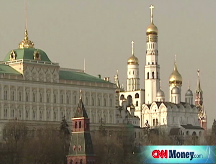Oil gains $3 on supply drain
Crude surges after a surprise drop in crude inventory and a bigger-than-expected gasoline drawdown.

NEW YORK (CNNMoney.com) -- Oil prices soared Wednesday after the government reported a surprisingly sharp decline in the nation's petroleum inventories.
U.S. crude for September delivery rose $2.99 to settle at $116 a barrel on the New York Mercantile Exchange.
Oil had traded up just 88 cents to $113.89 a barrel just before the report's release. The commodity surged by as much as $4.35 after the release before retreating slightly.
The Energy Department said crude supplies fell by 400,000 barrels during the week ended Aug. 8. The report also said gasoline supplies fell by 6.4 million barrels, while distillates, which are used to make diesel fuel, fell by 1.7 million barrels.
Economists polled by Platts, a division of McGraw Hill Cos., had expected the government to report a 500,000 barrel rise in crude stocks, a 2.2 million barrel decline in gasoline stockpiles, and a rise in distillates of 1.9 million barrels.
Refineries were operating at 85.9% of capacity, down from last week, and a sharper drop than the 86.25% predicted by the Platts poll.
Concerns that high fuel prices are cutting into demand have sent crude prices sharply lower in recent weeks.
Oil has been trending lower since the end of July and is down about $32, or 21%, from its all-time high.
However, the larger-than-expected decline in supplies suggested that demand may not have been as low as many investors had thought.
"This suggests that refiners are cutting back, and that should bring gasoline and, to a lesser extent, distillates back up," said Michael Lynch, president of Stretegic Energy and Economic Research in Winchester, Mass.
The reduced supplies came as fighting continued in a strategically important region of Eastern Europe.
Georgian conflict: Fighting between Russia and Georgia over the breakaway regions of South Ossetia and Abkhazia continued Wednesday, despite a cease-fire brokered by French President Nicolas Sarkozy. According to reports, Russian troops raided the strategically important city of Gori and pressed in the direction of Tbilisi, the nation's capital.
"The combination of the inventory [decline] and the war in Georgia gave people the incentive to buy [oil]," said Lynch.
Georgia serves as an important hub for transporting oil and natural gas between Europe and Asia.
The oil market has largely ignored threats to international supplies over the past few weeks as investors were more concerned about demand. Georgia's largest oil pipeline had been shut down before the fighting began due to a fire along its Turkish span, and worries about supply disruption failed to significantly rattle investors a day earlier.
However, Tom Orr, head of research for Weeden & Co. said he believes the oil market has been undervalued, and expressed concern about a disruption in supplies due to the conflict between Russia and Georgia that flared up this week.
"It amazes me how little attention crude oil traders have paid to the conflict between Russia and Georgia. A month ago crude would have shot up $5 or maybe even $10 per barrel if it looked like we might lose a million barrels per day of supply," wrote Orr in a research report.
Fuel-price pinch: Many investors believe the high price of fuel has been taking a toll on U.S. consumers.
The most recent evidence comes in a report on retail sales released Wednesday by the Commerce Department.
The report showed that retail sales had fallen slightly in July, but that sales of gasoline had grown nearly a percent due to higher prices at the pump.
"You strip out the gasoline and there's not much growth in what [consumers] are buying," said Rachel Ziemba, energy analyst at RGE Monitor.
Demand forecast: Many investors also believe the rising price of crude oil and gasoline has begun to cut demand in the United States, the world's largest oil consumer.
Gas prices remain more than a dollar higher than where they were 12 months ago. However, the average price of retail gas in the United States has fallen more than 8% to $3.787 a gallon at the pump over the past 27 days, according to motorist group AAA.
Prices have fallen below the psychological barrier of $4 a gallon in all but 8 states, according to AAA data. But that might be causing a slight uptick in demand.
"With the prices being down at the pump, I think people are starting to drive a little bit more," said Mark Waggoner, president of Excel Futures in California.
Dollar: Mixed view: Also adding to investor concerns was a mixed U.S. dollar.
The dollar sent conflicting signals to investors on Wednesday, turning slightly lower against the 15-nation euro, but rising versus the Japanese yen.
The U.S. currency has been steadily gaining strength amid worries about slowing economic growth outside the United States.
Oil is traded in dollars, so when the dollar strengthens, crude oil becomes relatively more expensive for foreign investors. Oil and other commodities are also commonly used as a hedge against inflation. ![]()



